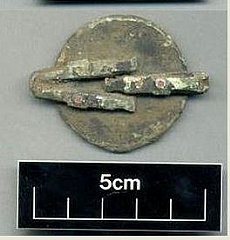Post-medieval Nested Weight Tests
01 July 2019
- News Type:
- Find of the Month

Nested weight sets of copper alloy have been found in a number of locations in the Highlands. Many are said to be made in Nuremberg, which produced large numbers for export in the post-medieval period until the 18th century. The cup-shaped weights sit one inside the other, providing portable and easily stored sets. Many were used by apothecaries to accurately measure ingredients, with the Nuremburg standard used widely in northwestern Europe.

Many are found at burgh sites. The example pictured above, from Ospisdale near Dornoch and now in Historylinks Museum, has a fleur-de-lis stamped on the bottom (the troy ounce standard for precious metal) and is likely therefore to have come from a set made in Nuremberg. A lid to a set, pictured to the right, was found at Camore, also near Dornoch.
Recent finds in Highland areas by metal detectorists and excavations include examples from around Dornoch, Fortrose, Tain and St Columba’s Chapel, Portree. Others are probably in local museums. A full list has not been compiled, though would show interesting connections and trade.
Further information
Connor, R.D. et al. 2004. Weights and Measures in Scotland: A European Perspective
HistoryLinks Image Library
nested weight
lid
And a warning on fakes on the market
Find of the Month Archive
- 25/07/2022 Steatite Vessels
- 10/04/2021 Cruisie lamp in Dunrobin Castle Museum
- 02/03/2021 Medieval Sword Pommel from Sleat, Skye
- 01/02/2021 Hilton of Cadboll Pictish Cross Slab
- 04/01/2021 Gunflint from Stoneyfield, Inverness
- 02/12/2020 Bobbin from Contin Bobbin Mill
- 02/11/2020 Russian Lead Cloth Seal from Cromarty
- 01/10/2020 The Poolewe Hoard
- 04/09/2020 Storr Rock Viking Silver Hoard
- 07/08/2020 Mesolithic bloodstone artefacts from Camas Daraich, Skye
